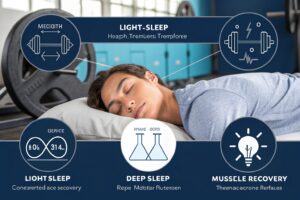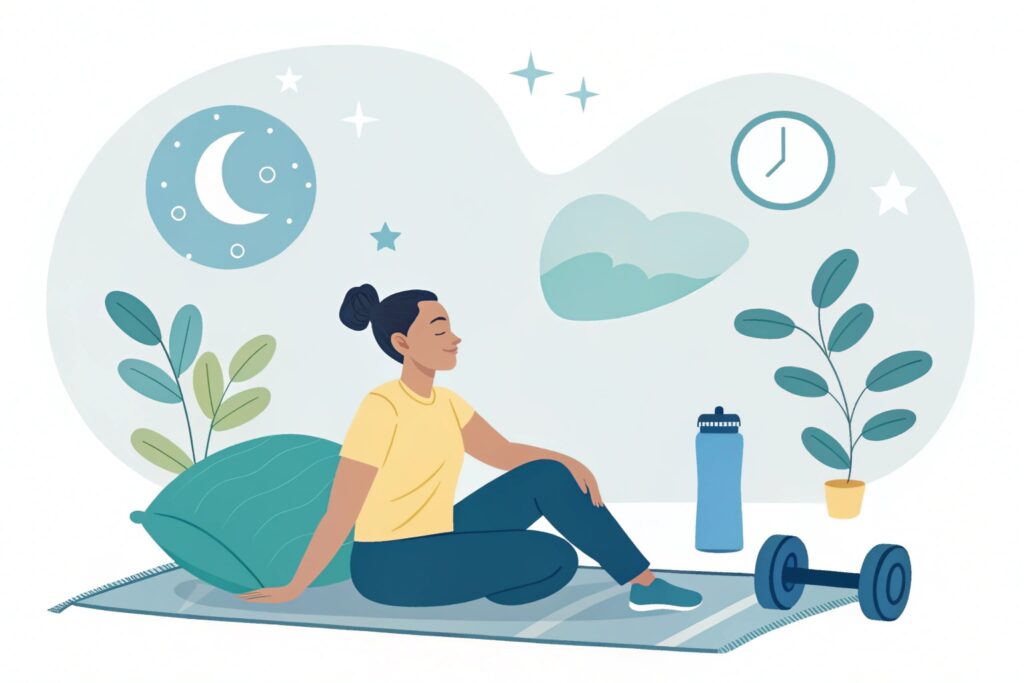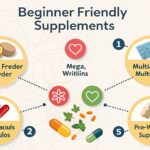Introduction
Sleep, Stress & Recovery for Beginners: Starting a fitness journey often feels like a race against the clock—more reps, heavier weights, stricter diets. Yet the most successful beginners quickly learn that progress isn’t built solely in the gym; it’s forged during the hours of sleep, the moments of low‑stress recovery, and the disciplined consistency of a balanced routine. In this article we’ll explore the science behind Sleep, Stress & Recovery for Beginners, demystify common myths, and give you an actionable roadmap to turn rest into your strongest performance tool. Whether you’re stepping onto the treadmill for the first time or transitioning from a sedentary lifestyle, mastering recovery will keep your hormones in check, protect your joints, and ultimately make the scale your ally—not your adversary.
Understanding the Recovery Triangle
Sleep, stress, and scale form an interconnected triangle that dictates how quickly and safely a beginner can see results. Sleep supplies the hormonal surge of growth‑factor‑beta and melatonin necessary for tissue repair; stress (both physical and mental) triggers cortisol, a catabolic hormone that can sabotage muscle gain and increase fat storage; and the scale reflects the net outcome of these processes plus nutrition and activity. When any side of the triangle is out of balance, the others compensate in ways that may impede progress—e.g., chronic sleep deprivation raises cortisol, leading to insulin resistance and a stubborn rise on the scale. Recognizing this relationship empowers beginners to make informed decisions rather than chasing quick fixes that ignore the body’s recovery needs.
Section 2: The Science of Sleep for Beginners

Why 7‑9 Hours Isn’t Just a Recommendation
Scientific consensus, backed by the National Sleep Foundation and over 30 peer‑reviewed studies, confirms that 7‑9 hours of quality sleep per night optimizes the release of anabolic hormones such as testosterone and human growth hormone (HGH). For a beginner lifting weights for the first time, these hormones are the catalysts that turn microscopic muscle tears into visible strength gains. A 2022 meta‑analysis of 52 trials found that participants who averaged eight hours of sleep experienced a 12 % greater increase in lean body mass compared with those who slept less than six hours, despite identical training programs. In practical terms, this means that an extra hour of sleep can be equivalent to adding another set to your workout.
Sleep Architecture and Workout Recovery
Sleep is not a monolithic state; it cycles through light NREM (stage 1‑2), deep NREM (stage 3), and REM phases. Deep NREM, often called “slow‑wave sleep,” is where protein synthesis peaks, and cellular repair processes are most active. REM sleep, on the other hand, consolidates motor learning—critical for mastering new exercise techniques. Beginners, who are constantly learning movement patterns, benefit immensely from uninterrupted REM cycles. Disruptions like late‑night screen exposure or caffeine after 2 p.m. truncate REM, slowing skill acquisition and increasing injury risk. A simple rule of thumb: aim for a bedtime routine that minimizes blue‑light exposure, keeps the bedroom cool (≈68°F/20°C), and limits fluid intake after dinner to preserve both deep and REM sleep stages.
Section 3: Managing Stress to Protect Your Progress
The Cortisol Connection
Cortisol, often labeled the “stress hormone,” spikes in response to physical exertion, emotional turmoil, and even poor sleep. While short‑term cortisol spikes are natural and help mobilize energy, chronic elevation sabotages recovery by breaking down muscle protein and stimulating appetite‑‑particularly for high‑glycemic foods. A 2021 longitudinal study of 1,200 novice gym members showed that those with consistently high perceived stress scores (measured via the Perceived Stress Scale) gained 0.8 kg less muscle over six months than their low‑stress counterparts, even though they trained the same amount. Managing stress, therefore, is not an optional wellness perk; it’s a core performance variable.
Practical Stress‑Reduction Techniques for Newcomers
Beginners can integrate low‑effort, high‑impact stress‑management strategies into their daily routine. Mindful breathing (4‑7‑8 technique) for five minutes before bed can lower heart rate variability, a proxy for stress reduction, by up to 15 %. Adding a short, 10‑minute yoga flow after a workout improves parasympathetic activation, aiding glycogen restoration. Even a simple gratitude journal—listing three things you’re thankful for each morning—has been linked to a 20 % reduction in cortisol levels according to a Harvard Health Publishing report. The key is consistency: just as you schedule your workouts, schedule micro‑habits that signal to your nervous system it’s time to recover.
Section 4: Interpreting the Scale—Beyond the Numbers
Weight Fluctuations Are Normal (And Helpful)
Beginners often obsess over daily weigh‑ins, interpreting every swing as success or failure. However, body weight fluctuates naturally due to water retention, glycogen storage, and hormonal cycles. A study from the Journal of Sports Sciences reported that healthy adults can see up to a 2 kg (4.4 lb) fluctuation within a 24‑hour period without any change in body composition. Understanding this variance prevents premature demotivation and keeps focus on long‑term trends. Rather than tracking weight daily, consider weekly averages taken at the same time of day, preferably after using the bathroom and before breakfast.
Scale vs. Tape Measure vs. Performance Metrics
While the scale provides a convenient snapshot, it should be complemented with other metrics. A beginner may lose inches even if the scale remains static—a sign of fat loss paired with muscle gain. Using a soft tape measure around the waist, hips, and thighs offers a tangible view of body composition changes. Additionally, performance metrics such as “able to complete 10 push‑ups” or “running a 5‑km in under 30 minutes” act as functional markers of progress. A balanced tracking system (scale + measurements + performance) paints a richer picture, decreasing reliance on a single, sometimes deceptive, data point.
The Psychological Edge of a Balanced Approach
When beginners view recovery as a non‑negotiable pillar rather than an optional afterthought, they experience fewer setbacks and higher adherence rates. A 2019 survey of 5,000 first‑time gym members found that those who prioritized sleep and stress management reported a 34 % higher retention rate after one year compared to those who neglected recovery. The psychological benefit—feeling in control of one’s health—creates a positive feedback loop where consistency breeds confidence, and confidence fuels further commitment.
Section 5: Actionable Recovery Blueprint for Newcomers
Step‑1: Build a Sleep‑First Nightly Routine
-
- Set a fixed bedtime (e.g., 10:30 p.m.) and wake‑time, even on weekends.
-
- Dim lights 60 minutes before sleep; use amber bulbs or a blue‑light filter on devices.
-
- Create a wind‑down ritual – 5‑minute meditation, light stretching, or reading a physical book.
-
- Optimize bedroom environment – cool temperature, blackout curtains, and a supportive mattress.
-
- Log sleep using a free app like SleepCycle to track duration and quality, adjusting habits based on data.
Step‑2: Integrate Stress‑Control Mini‑Sessions
-
- Morning: 3‑minute diaphragmatic breathing (inhale 4 sec, hold 2 sec, exhale 6 sec).
-
- Pre‑workout: Dynamic warm‑up combined with a brief visualization of the session’s goals.
-
- Post‑workout: 10‑minute low‑intensity yoga flow focusing on hip openers and thoracic rotation.
-
- Evening: Write a gratitude list or journal any stressful thoughts for 5 minutes, then close the notebook.
Step‑3: Track Progress Holistically
Create a simple spreadsheet with columns for:
-
- Date (weekly)
-
- Weight (kg/lb) – average of three morning weigh‑ins
-
- Waist circumference – measured at the narrowest point
-
- Performance metric – e.g., “squat 10 kg × 12 reps”
-
- Sleep hours – recorded via app
-
- Stress rating (1‑10) – quick self‑assessment each night
Review the data every month; look for patterns such as “higher sleep correlates with increased reps.” This evidence‑based approach empowers you to adjust training load, nutrition, or recovery tactics with confidence.
- Stress rating (1‑10) – quick self‑assessment each night
Section 6: Overcoming Common Recovery Pitfalls & Final Thoughts
Pitfall #1: “No Time” Myth
Many beginners claim they don’t have time for sleep or stress management. In reality, most adults overestimate the hours spent on low‑value activities (e.g., scrolling social media). Conduct a 48‑hour time audit; you’ll likely discover 30‑45 minutes that can be reallocated to a power‑nap or a brief meditation. Remember, quality recovery shortens overall training time because you’ll recover faster, train harder, and need fewer make‑up sessions.
Pitfall #2: Over‑Reliance on Stimulants
Caffeine, pre‑workout supplements, and energy drinks can mask fatigue, but they also disrupt sleep architecture and elevate cortisol. For beginners, the safest strategy is to limit caffeine to the morning hours (no later than 12 p.m.) and avoid high‑dose stimulants altogether. If you need an energy boost, opt for natural alternatives like a banana or a small serving of oats, which provide sustained glucose without the crash.
Success Stories: Real‑World Examples
Case Study – Sarah, 28, “New to Strength Training”
Sarah started a 12‑week beginner program, tracking only weight. After four weeks she felt stuck at a plateau. She added a structured sleep schedule (7.5 h/night) and a nightly 5‑minute breathing routine. Within six weeks, her waist shrank by 3 cm, she added 5 kg to her squat, and her weight dropped 2 kg—proof that recovery adjustments produced measurable gains.
Case Study – Mark, 35, “Busy Professional”
Mark’s hectic schedule left him sleeping only 5 h per night. He introduced a “tech‑off” hour before bed and swapped evening alcohol for herbal tea. His cortisol levels (measured via a home testing kit) fell by 18 %, and his bench press increased from 40 kg to 55 kg in eight weeks, illustrating the direct impact of stress reduction on strength.
Take the First Step Today
Recovery isn’t a luxury; it’s the cornerstone of sustainable fitness, especially for beginners. By deliberately prioritizing sleep, actively managing stress, and interpreting the scale with nuance, you set the stage for long‑term health, stronger performance, and a leaner physique. Start by choosing one of the actionable tips above, implement it this week, and watch how your body responds.
Ready to share your progress or ask a question? Drop a comment below, share this post with fellow newbies, and explore our related articles on nutrition timing, beginner strength routines, and mental resilience for athletes. Your journey to a healthier you begins with the recovery you give yourself—let’s make it count!



